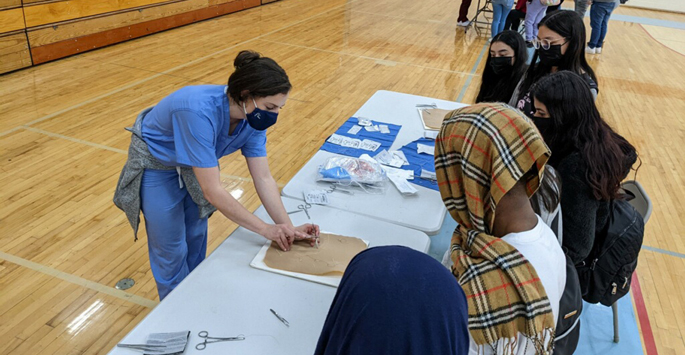
More than 200 high school students at four Metro Nashville Public Schools (MNPS) in March participated in hands-on activities and listened to a diverse group of Vanderbilt residents, fellows and medical students talk about why and how they chose to become physicians.
The outreach event, sponsored by the House Staff Diversity and Inclusion Alliance (HSDIA) and the Vanderbilt University School of Medicine Social Mission Committee, took place at Nashville’s Maplewood, Cane Ridge, Glencliff and Overton High Schools.
About 30 house staff and medical students participated.
“We wanted to find ways we could impact the Vanderbilt community, within the Medical Center, but also ways we could engage with the community. Our plan was to improve visibility of the medical profession within Metro Nashville Public Schools and find ways to build connections with students with hopes of increasing their interest in pursuing medicine in the future,” said Brandon Esianor, MD, a resident in the Department of Otolaryngology/Head and Neck Surgery and co-chair of the HSDIA.
MNPS, with its large number of diverse students, was ideal for the outreach event, Esianor said.
“Within medicine, there’s a huge gap of representation from the underrepresented minority standpoint. We felt that targeting this subset of students early in the process, we could make some sort of impact in letting them know ‘hey look, regardless of where you come from, regardless of your backstory, you can be a doctor, and we’re here to show you that and be your champions and cheerleaders. We’re here to motivate you, to show you this is a possibility for you one day in the future.”
Hassan Fakhoury, a third-year medical student, was instrumental in planning the program.
He said the event was initially supposed to be just the residents, fellows and medical students telling their stories, but feedback from MNPS indicated the students wanted a more hands-on event.
So, it evolved into two sessions — the first, with hands-on activities like suturing, tying knots, and interaction with a 3D anatomy model — and the second, an educational presentation featuring information about medical conditions of a celebrity that are public knowledge from a popular documentary familiar to most of the teenagers.
Volunteers at each site briefly shared their unique “journey to medicine” stories as a means to motivate the students, followed by a question-and-answer session to conclude the event.
“I was shocked by the inquisitive questions they were asking. They were beyond the high school level,” Esianor said.
The feedback from both groups has been positive and affirming, the organizers said. There are plans to expand the event next year since they were only able to visit four high schools, but had interest from 12.
In addition to the HSDIA and the Medical School’s Social Mission committee, the event was made possible by the support of Vanderbilt University Medical Center’s Office of Graduate Medical Education and the KLS Martin Group, a medical device company that donated eight skulls that students were able to keep at the conclusion of the event and 3D figures for demonstrations supplied by Cameron Henry, a fourth-year radiology resident.
Following the event Fakhoury received a message that one of the Maplewood students at the presentation decided that day to become a family medicine doctor and serve his community because he was motivated by the program.
“That’s what this event is all about — if you impact just one person, the number of people they’re going to go off and impact is endless,” Esianor said. “It makes spending two hours engaging with these students so worthwhile.”
The Vanderbilt group also benefited.
“Medical training is extremely rigorous,” Esianor said. “It’s filled with lots of highs and some lows, unfortunately, but being able to go out and meet with these students and have an impact in a way that’s not necessarily part of our daily routine is refreshing for those of us who participated in the event. We got a lot of fulfillment out of being able to have a positive impact on this community of students.”












